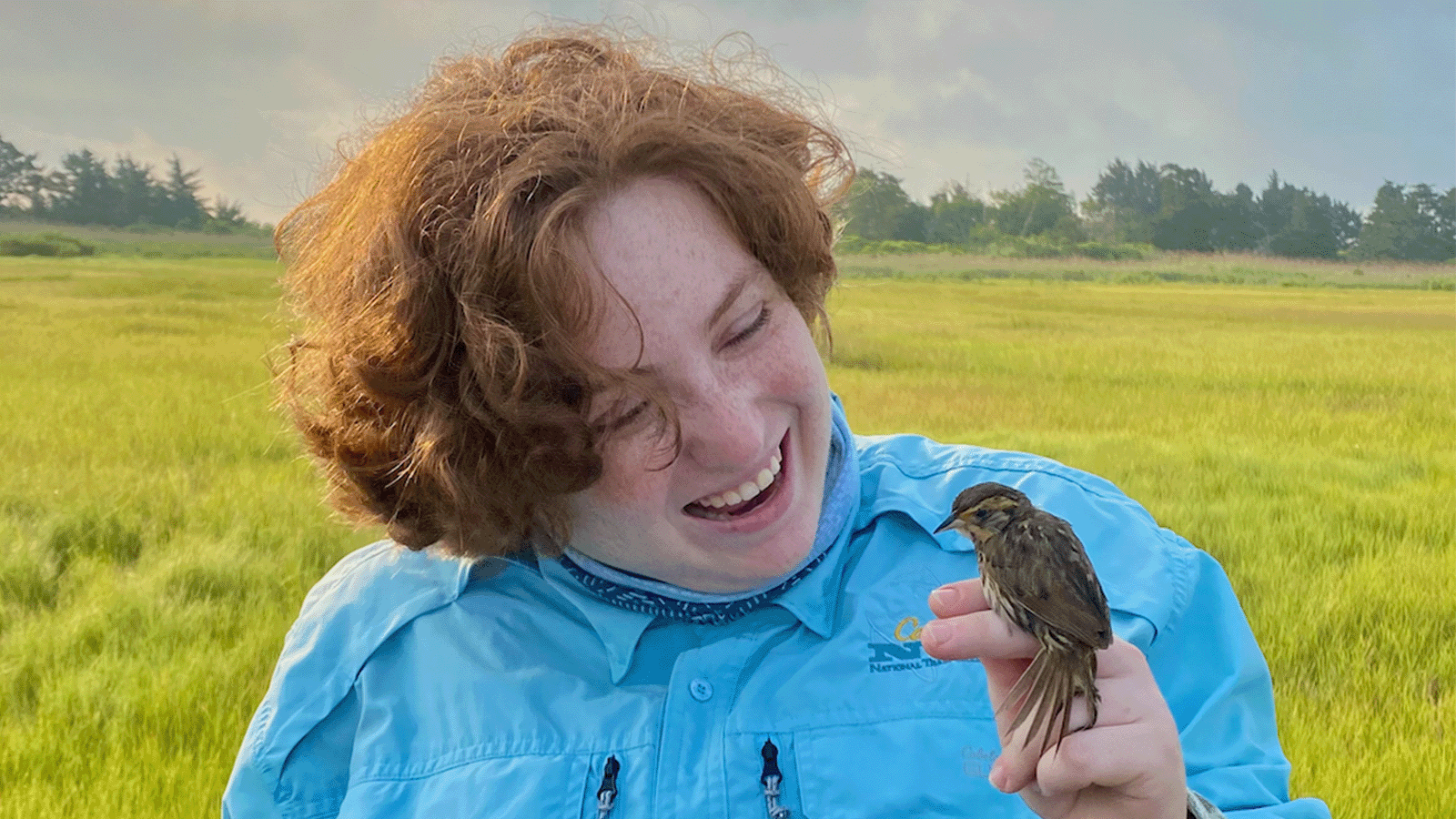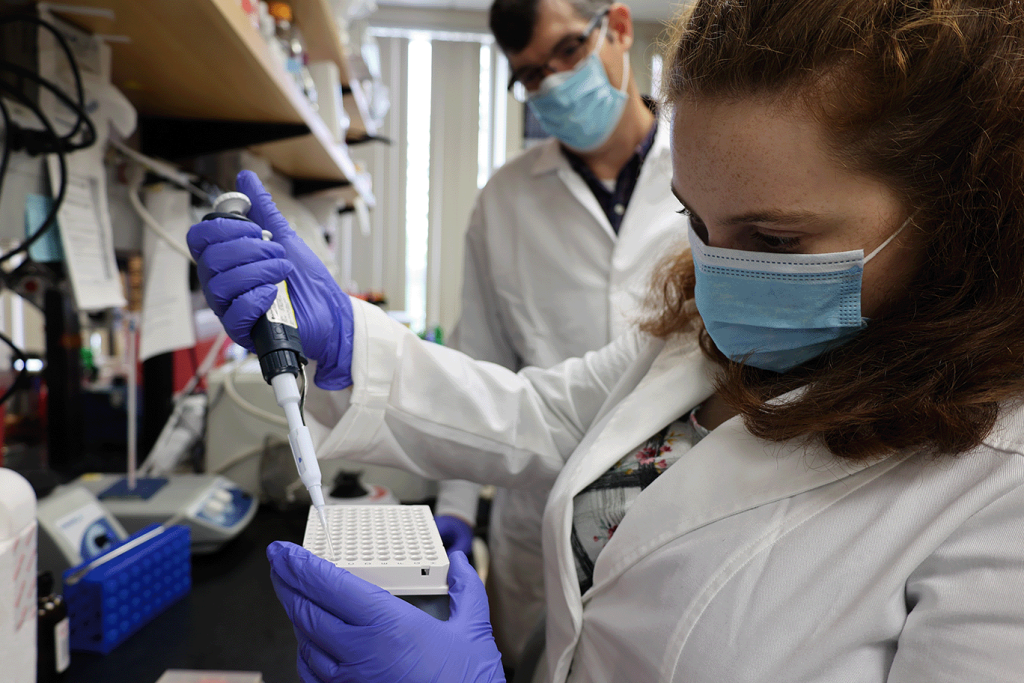
Genomic Architecture: RNA research of tidal marsh sparrows under the influence of environmental stressors
By Stefania Irene Marthakis and Colin Gallagher, Media Intern
In the field of RNA (ribonucleic acid) research, the NSF EPSCoR RII Track-2 grant, GECO (Genomic Ecology of Coastal Organisms: A Systems-Based Research and Training Program in Genome-Phenome Relationships in the Wild) has made significant research progress in understanding the interaction and differences in genotypes and phenotypes. More specifically, GECO’s research has examined similarities and differences in the genes that code for microRNAs (miRNAs), small RNAs that regulate other genes, among various species of sparrows in saltmarsh (a.k.a. tidal marsh) environments. These RNA molecules are isolated and sequenced (a method used to discover the exact order of the four nucleotides that make up all RNA molecules in a cell) in large quantities and then analyzed.
Kayla Barton is a Ph.D. candidate of Biochemistry and Molecular Biology at the University of Maine (UMaine). Studying under Benjamin King (UMaine Associate Professor of Bioinformatics), Barton’s research role has involved characterizing and annotating miRNAs of tidal marsh sparrows in order to understand differences in genetic structure.

Advances in sequencing and bioinformatics allow for rapid characterization of genomes that include both coding and non-coding genes. Coding genes are transcribed into RNA that are then translated in proteins which have important functions in different tissues. Non-coding genes are transcribed into RNA and these RNA molecules go on to regulate the function of other genes. RNAs and miRNAs (endogenous, small non-coding RNA) in the human body are able to regulate the messenger RNAs (mRNAs), which encode protein. MiRNAs are either perfectly or partially complementary to mRNAs. If perfectly complementary, miRNA will cleave the mRNA, rendering it useless. If partially complementary, miRNA will block the translation of the mRNA.
“I like to describe it as a bakery,” Barton said. “Each cell in your body is a bakery; your proteins are all different types of pastries that fill certain needs. You have the recipes for those pastries, which is your genome. Then you have the bakers, who are your messenger RNAs. And finally, you have the bakery managers, who are the microRNAs that tell the bakers (messenger RNAs) what they can and can’t make.”
GECO’s research hopes to address and answer challenges and objectives within the field of genomics, such as studying how variation in gene expression leads to phenotypic plasticity. The non-coding RNA team researches the function of non-protein coding genes and seeks to characterize genetic variation in these regulatory genes across their focal sparrow species (animals that provide an essential ecological function).
Barton explained, “We sequence miRNA from Saltmarsh, Savannah, and Nelson’s Sparrows and then determine how the complements of miRNAs compare across these species. Are miRNAs expressed in tidal marsh sparrows different from more inland species? And if so, which genes do those miRNAs regulate?”
When analyzing the sequence data, Barton utilizes a variety of software tools, most importantly miRDeep2, which can predict miRNAs. This software runs on High Performance Computing (HPC) clusters that allow the team to analyze the sequence data. Barton then uses another software, BLAST, to align these predicted miRNAs to known miRNAs, allowing her to annotate known and potentially novel miRNAs in different sparrow species. “These are complex workflows that require a lot of technical and programming skills combined with biological knowledge,” King stated. “Barton has the right combination of skills for this challenging project.”
Barton has also helped design an important genetic analysis tool for the GECO team that will be used to simultaneously sequence about 1,000 regions in the genomes of hundreds of individual sparrows. GECO is creating a “Genotyping by Thousands sequencing” (GT-seq) panel that will allow the team to inexpensively find differences in about 1,000 genes that the team has carefully selected. These genes include the miRNAs that Barton has annotated in the sparrows. Barton has assisted King with building the pipeline that designs the specific regions within the genes featured in the GT-seq panel. The GT-seq panel is an important tool for the GECO team to test whether specific sequence variants in the selected genes can be associated with different tidal marsh sparrow phenotypes. “Everyone on the project has picked a set of genes they are interested in that have been shown to affect their various projects,” Barton said. For example, Alice Hotopp (UMaine Ph.D. Candidate in Ecology and Environmental Sciences) is studying genes associated with pigmentation as tidal marsh sparrows have different melanism patterns in their feathers.
While on track to receive her Ph.D. in Biochemistry and Molecular Biology, Barton believes that research into miRNAs has huge potential, as it can be useful to understand how genes are regulated in a variety of organisms, including tidal marsh sparrows. “MiRNAs may be some of the genes that contain particular sequence variants that enable these sparrows to tolerate living in high stress, salty environments,” Barton explained. “By being able to understand that better, maybe we can apply that knowledge to helping to treat human disease. For example, miRNA therapeutics may someday help people with kidney disease where defective osmoregulation leads to water retention and cardiovascular disease.”
As part of her dissertation, Barton is looking at miRNAs that target a specific gene that is potentially involved in osmoregulation (the process of maintaining salt and water balance). Barton concluded, “There are a lot of potential studies that could come from this if we have an annotation of these miRNAs because they are essentially the regulators.” Using her research and analytical skills, Barton plans to continue on to postdoctoral studies after graduation with the goal of working as a bioinformatics expert in industry.
